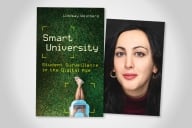You have /5 articles left.
Sign up for a free account or log in.
Academics who specialize in using technology to conduct and enable new kinds of humanities research are in high demand. At the same time, the current ecosystem of scholarly publishing can be inhospitable to their often-idiosyncratic research projects.
Two well-known organizations are teaming up with a handful of colleges and universities to try to change that by building a flexible platform where digital humanists could have their research published and certified that the work has passed through well-respected editorial gantlets.
The platform, called Anvil Academic, is a joint project by the National Institute for Technology in Liberal Education (NITLE) and the Council for Library and Information Resources (CLIR). Anvil aims to make it easier for digital humanists to publish nontraditional scholarly work under the auspices of traditional outlets, such as university presses.
“Increasingly, research in the humanities is dependent on large data sets and involves sophisticated algorithms and visualizations in the execution of that research and in the construction of the products of scholarship,” said Chuck Henry, the president of CLIR, in a statement. “Anvil will capture the environment in which this research is conducted: a linked ecology of scholarly expression, data, and tools of analysis that will over time become itself a place for new knowledge discovery.”
The idea is that visitors could log in to the Anvil online gateway — he says whether Anvil will be subscription-based or open-access is yet to be determined — and browse through various digital research “objects,” such as searchable archives, game-based simulations and interactive maps of historical environments. Ideally, visitors will also be able to view the underlying data, media files and algorithms upon which the project is built, he says. These ingredients could be filed in a registry that other scholars could search and borrow from, Henry says.
One of Anvil’s goals is to build a peer-review infrastructure for research that cannot be easily represented in text. While the digital humanities are widely considered an important frontier, tenure and promotion committees still have trouble evaluating the work of digital humanists because the format is often so unfamiliar.
This problem is compounded by the fact that digital humanists cannot point to any scholarly press imprimatur as a signal that their work is worthy, Joey King, the executive director of NITLE, said in an interview. Most academic presses are still figuring out their strategies on e-books, he says; they do not have the time or money to devote to new infrastructure for digital humanities projects. By outsourcing the platform and technical aspects to Anvil, the presses would need only to round up reviewers fluent in digital scholarship to vet submissions, King says.
“Tenure and review committees go on the quality of the peer review,” King says. If a foreign-looking research object lives in the Anvil stable and bears the seal of Stanford University Press, “they’re more likely to think that’s solid work,” he says.
Anvil does not currently have any official partnerships with university presses. It does, however, have commitments of financial and staff support from Stanford University, the University of Virginia, Washington University in St. Louis, Bryn Mawr College, Amherst College, Middlebury College, and Southwestern University; a board of directors packed with well-known digital scholarship advocates such as Ed Ayers, president of the University of Richmond, and Michael Keller, the university librarian at Stanford; and $400,000 in the bank.
Some institutions that do not have academic presses might nonetheless be interested in developing an editorial infrastructure to bless Anvil-hosted digital scholarship. “We’re thinking that there could be a publishing outlet of the tri-college digital humanities that would use Anvil as its publishing platform,” says Elliott Shore, chief information officer at Bryn Mawr, speaking of his own institution and neighboring Swarthmore and Haverford Colleges. (Shore qualified this by saying there are no formal plans behind this — just talk.)
Anvil does not have anything built yet, other than some strategic alliances. Still, it hopes to co-publish “four or five” digital scholarly works before the end of the year, according to Henry.
Daniel Cohen, the director of the Center for History and New Media at George Mason University, agreed that the demand for infrastructural services for digital humanities publishing is there. “When I talk to the directors of university presses,” he says, “they say they want to move into native formats for [digital humanities], but they don’t have the budget or the technical staff to run these platforms themselves.”
Cohen says Anvil’s vision of its role as a technical partner for traditional academic publishers accords with his own view of the future of scholarly communications, in which “ the university press turns into more of a stamp of approval, [providing] vetting of scholarly materials rather than the entirety of scholarly production at scale.”
For the latest technology news and opinion from Inside Higher Ed, follow @IHEtech on Twitter.








